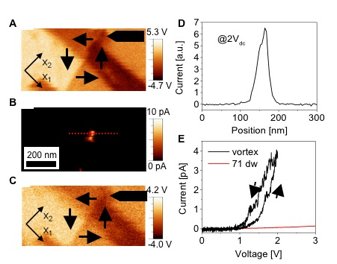Nov 10 2011
Adaptive 1D structures in condensed matter systems offer a powerful paradigm for nanoscale device engineering due to the combination of unique physical properties and capability for manipulation by external magnetic, electric, or strain fields without the disruption of the host lattice. The examples include vortices in superconductors, defects in topological insulators and topological defects such as domain walls in ferroics.
 Enhanced electric conductivity at ferroelectric vortex cores in BiFeO3. (a) In-plane PiezoForce Microscopy image of a vortex domain structure. (b) Conducting-Atomic Force Microscopy (c-AFM) image at 2 Vdc showing enhanced conductivity at vortex core. (c) Vortex after c-AFM shows no change in domain structure. (d) Extracted line from c-AFM image indicated in B. (e) I-V curves measured with stationary tip in vortex center (black) and at a 71° domain wall (red).
Enhanced electric conductivity at ferroelectric vortex cores in BiFeO3. (a) In-plane PiezoForce Microscopy image of a vortex domain structure. (b) Conducting-Atomic Force Microscopy (c-AFM) image at 2 Vdc showing enhanced conductivity at vortex core. (c) Vortex after c-AFM shows no change in domain structure. (d) Extracted line from c-AFM image indicated in B. (e) I-V curves measured with stationary tip in vortex center (black) and at a 71° domain wall (red).
The numerous examples of novel functionalities include domain wall ferroelectricity in paraelectric materials, enhanced electronic conductivity, magnetoelectric coupling, magnetic phase transitions and ionic phenomena. This potentially enables a broad spectrum of reconfigurable magnetoelectric, optoelectonic, and strain-coupled memory and logic devices enabled by domain engineering.
However, all experimental and theoretical studies to date explored the properties of 2D topological defects such as ferroic domain walls. At the same time, implementation in electronic devices requires the capability to create and modify 1D conductive objects, effectively creating "wiring" in functional devices. An important step into the controlled creation and probing of the electronic properties of 1D topological defects has now been achieved by a collaboration between researchers from Oak Ridge National Laboratory (Sergei Kalinin and coworkers, CNMS), MESA+ Institute for Nanotechnology (Mark Huijben, IMS), University of California Berkeley, University of Arkansas, Pennsylvania State University, National Chiao Tung University, National Academy of Science of Ukraine, University of New South Wales and CNRS Paris. The results have been published in Nature Physics.
The unique aspect of the core structure, and the origin of the observed localized conductivity, is that the core structure can undergo a reversible transformation into a metastable twist structure. The associated change of the out-of-plane polarization vector occurs against the favorable orientation of the electric field, creating a topologically confined analogue of a charged domain wall. The vortex core is therefore a dynamic conductor and it raises a possibility of a 1D conduction channel through the whole thickness of the BiFeO3 film. Hence, this demonstrates the controlled creation of 1D topological defects in ferroic materials and reports the enhanced electronic transport along the vortex/anti-vortex core. This study opens the pathway for the unusual states of matter stabilized at the defect cores, and opens the pathway for electronic device fabrication.